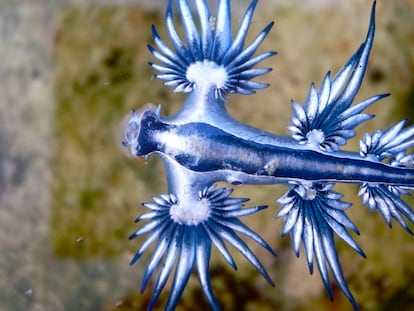
An unusual marine organism was found on the Catalonia coast in September 2025—a bright blue mollusk known as the Glaucus dragon (Glaucus atlanticus). This marks the first recorded appearance of this creature on Catalan beaches. Three specimens discovered on the sand near Tamarit (Tarragona) were carefully collected and sent to laboratories at the University of Barcelona for further study.
Researchers intend not only to thoroughly examine the biology of this enigmatic creature, but also to work on decoding its genome. Of particular interest is the Glaucus dragon’s ability to accumulate and use toxins obtained from its prey—venomous jellyfish and other marine organisms. Scientists hope that these substances could become the basis for new pharmaceuticals, as has already happened with other marine species used in the fight against cancer.
The Glaucus dragon is a member of pelagic nudibranch mollusks, distinguished by its unusual lifestyle. It floats on the water’s surface, staying afloat thanks to an air bubble, and its bright coloration helps it blend in both from predators and birds. From above, its body merges with the color of the ocean, while from below—with the sky, making it almost invisible.
The habitat of this mollusk includes the warm and tropical waters of the Atlantic, Indian, and Pacific Oceans, while in the Mediterranean Sea it appears only occasionally, carried in by ocean currents. It feeds exclusively on poisonous hydrozoans, such as the Portuguese man o’ war (Physalia physalis), and is not only able to tolerate their venom but also uses it for its own protection by accumulating the dangerous cells in special organs.
Scientists at the University of Barcelona plan to find out how Glaucus is able to ‘capture’ and process toxins without harming itself. This could open new avenues for pharmacology. Despite its toxicity, this mollusk is virtually harmless to humans: its sting causes only mild skin irritation, and no serious cases have been recorded. The size of an adult does not exceed four centimeters, and its toxicity is incomparable to the danger posed by the Portuguese man o’ war.
Experts note that the appearance of Glaucus is linked to climate change and the gradual warming of the Mediterranean, which encourages the arrival of new species. However, this mollusk is not considered invasive and does not pose a threat to the ecosystem or vacationers.
Biologists emphasize that marine nudibranch mollusks are a real treasure trove of biologically active compounds. Some of these are already used in medicine: for example, substances from large sea slugs have formed the basis of modern anticancer drugs, while toxins from marine snails are used as painkillers for chronic pain. Scientists are confident that the depths of the sea still hold many such discoveries that could transform the approach to treating serious illnesses.
For research to continue successfully, stable support for science and the development of infrastructure are essential. Only in this way can the marine ecosystem’s natural wealth be turned into real medical innovations. In addition, experts call for active citizen involvement and collaboration between research centers to gain a better understanding of the marine fauna of Catalonia, especially in the context of a changing climate.






